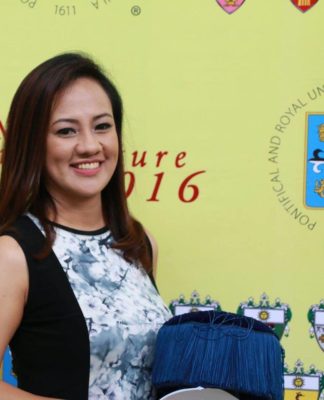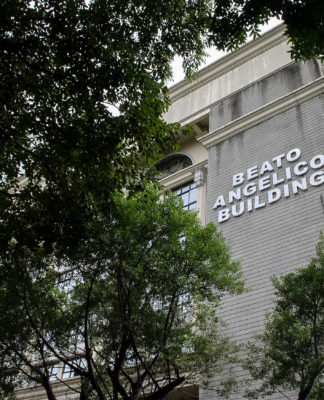STRAIGHT from canonization rites in Rome last Oct. 21, the image of San Pedro Calungsod visited the University last Oct. 25, drawing thousands of devotees.
The University was the first station assigned for the “Duaw Nasud” (national visitation), described by organizers as a national pilgrimage of thanksgiving for Calungsod, the second Filipino saint.
“Martyrdom is not just about dying. It is as much as living one’s life to the full,” Rector Fr. Herminio Dagohoy, O.P. said in his homily. “I believe that this University is blessed because martyrs lived and visited UST. [It] is with fervent joy that I welcome and receive the image of San Pedro Calungsod.”
UST’s carillon bells—a memorial to saints and martyrs produced by the University—rang to signal the entry of the image at Santisimo Rosario Parish Church.
Dagohoy added that martyrs do not only show the noble way to die, but also teach the Church how they must live faithfully in accordance with the Catholic faith.
“There are no accidental martyrs. Whether we live a life like [that of] Pedro Calungsod, Lorenzo Ruiz, UST Martyrs, or Mother Theresa who worked for the poor… since their lives were oriented to self-giving love, the impact of such love changes people,” Dagohoy said.
After the celebration of the Holy Eucharist, the image was venerated and a vigil was opened to the public. It was followed by a sendoff Mass last Oct. 26. The image was then brought to the Immaculate Conception Cathedral Parish in Pasig for the second station of Duaw Nasud.
Aside from Calungsod, Pope Benedict XVI canonized six other martyrs: Jacques Berthieu of France, Maria Anna Cope and Maria Schaeffer of Germany, Giovanni Battista Piamarta of Italy, and Maria del Carmen of Spain.
Meanwhile, Eilleen Esteban, president of Youth Pinoy and one of the delegates to Calungsod’s canonization in Rome, described Calungsod as a model for the youth.
“I think it’s very important that the youth nowadays would have a hero figure. I think that’s what young people look upon now. It’s good to start your life early serving the Lord and offering your life to him,” Esteban said.
Calungsod was 14 years old when he was chosen to join the Jesuit priests in their mission to the Island of Ladrones, now called Island of Marianas.
He died at the age of 17 on April 6, 1672 with Jesuit priest Fr. Diego Luis San Vitores, his companion in missionary work in Guam. Both were killed by two natives for preaching Christianity.
According to accounts, the young catechist could have escaped but Calungsod chose to stay with San Vitores. The priest was able to give absolution to Calungsod before his death.
Tedious canonization process
In a symposium for the celebration of National Laity Week at the Education Auditorium of Albertus Magnus Bldg. last Sept. 28, Cebu Archbishop Emeritus Ricardo Cardinal Vidal recounted the beatification and canonization process for Calungsod.
When Pope John Paul II asked all the bishops to submit a new list of martyrs eligible for beatification, Vidal nominated Calungsod through a formal letter.
The Pope asked: “A Filipino?”
Cardinal Vidal said “Yes,” after which he saw the Pope writing in the margin of his letter with his signature: “Please attend to this.”
Within months, in the year 2000, Pedro Calungsod was beatified.
After Calungsod’s beatification, Vidal endorsed him for sainthood, but was disheartened upon seeing that there were more than 400 candidates for canonization.
Initially, Vidal doubted that the Filipino candidate would be prioritized because there were many famous names on the list of nominees, including Mother Teresa of Calcutta and Blessed John Paul II.
“There were books [on the different candidates for sainthood] from the floor all the way to the ceiling,” said Vidal, who is also the chairman of the National Commission for the canonization of Calungsod. “The Vatican prefect [Cardinal José Saraiva Martins] said do not lose hope.”
Fr. Catalino Arevalo, S.J., author of “Pedro Calungsod: Young Visayan Proto-Martyr,” said Calungsod should be the patron of this year of “New Evangelization” as the Catholic Church prepares to celebrate 500 years of Christianity in the Philippines in 2021. The year 2021 marks the 500th anniversary of the arrival of the expedition of Magellan and the first Mass in Limasawa in 1521.
“[His canonization is] an act of divine providence,” Arevalo said. “[Calungsod] sums up for us so much of what we need to do. He committed his entire life and future to mission.”
In a Mass at the Santisimo Rosario Parish last Sept. 28, Manila Archbishop Luis Antonio Tagle highlighted the significance of the two Filipino martyrs: Calungsod and San Lorenzo Ruiz, in the lives of the Filipinos.
“It is good for the Church of the Philippines to receive the grace of two lay saints and martyrs,” Tagle said in his homily. “They are so convinced about the truth of God in Jesus that they can bear anything. They are willing to make the supreme sacrifice of offering their lives for the truth.”
Tagle said the canonization of the two Filipino martyrs is not only a “boost to the lay vocation and ministry, [but] God’s way of telling [the] lay people in the Philippines that [they] are the bearers of holiness and sanctity.”
Silver anniversary of Lorenzo Ruiz’s sainthood
Meanwhile, the Church celebrated the 25th year of the canonization of Saint Lorenzo Ruiz, the first Filipino saint, last Oct. 18.
Born in Binondo, Manila in the 17th century, San Lorenzo became an altar boy at the Binondo Church. With the Dominicans, he left the country in June 1636 to go to Nagasaki, Japan where they were captured and tortured by the Tokugawa shogunate— a regime known for prosecuting Christians.
On Sept. 27, 1637, they were brought to the “Mountain of Martyrs” where San Lorenzo suffered “horca y hoya,” said to be the most painful form of dying. They were hung upside down into a pit, with rocks attached to them to add weight. Two days after, Lorenzo Ruiz died.
Tagle recounted San Lorenzo’s words of martyrdom: “I shall die for God, and for Him I will give many thousands of lives if I had them.”
“Suffering is what a martyr embraces as a consequence of witnessing to the truth,” Tagle said. “It is not identification of Christ once. It is a thousand times.”
According to former Ambassador to the Vatican Henrietta de Villa, the feast of Saint Lorenzo Ruiz is called “Dies Natalis,” Latin for definitive birth, which refers to the martyrs’ birth into heaven. The date of the martyr’s death is considered his or her immediate transition to immortal life.
Pope John Paul II beatified Lorenzo in his visit to Manila on Feb. 18, 1981 and canonized him on Oct. 18, 1987.
While the icon of Saint Lorenzo Ruiz holds a rosary, the image of Blessed Calungsod can be seen holding Doctrina Cristiana, the first book published in the Philippines by the Dominicans. Denise Pauline P. Purugganan and Gracelyn A. Simon
















